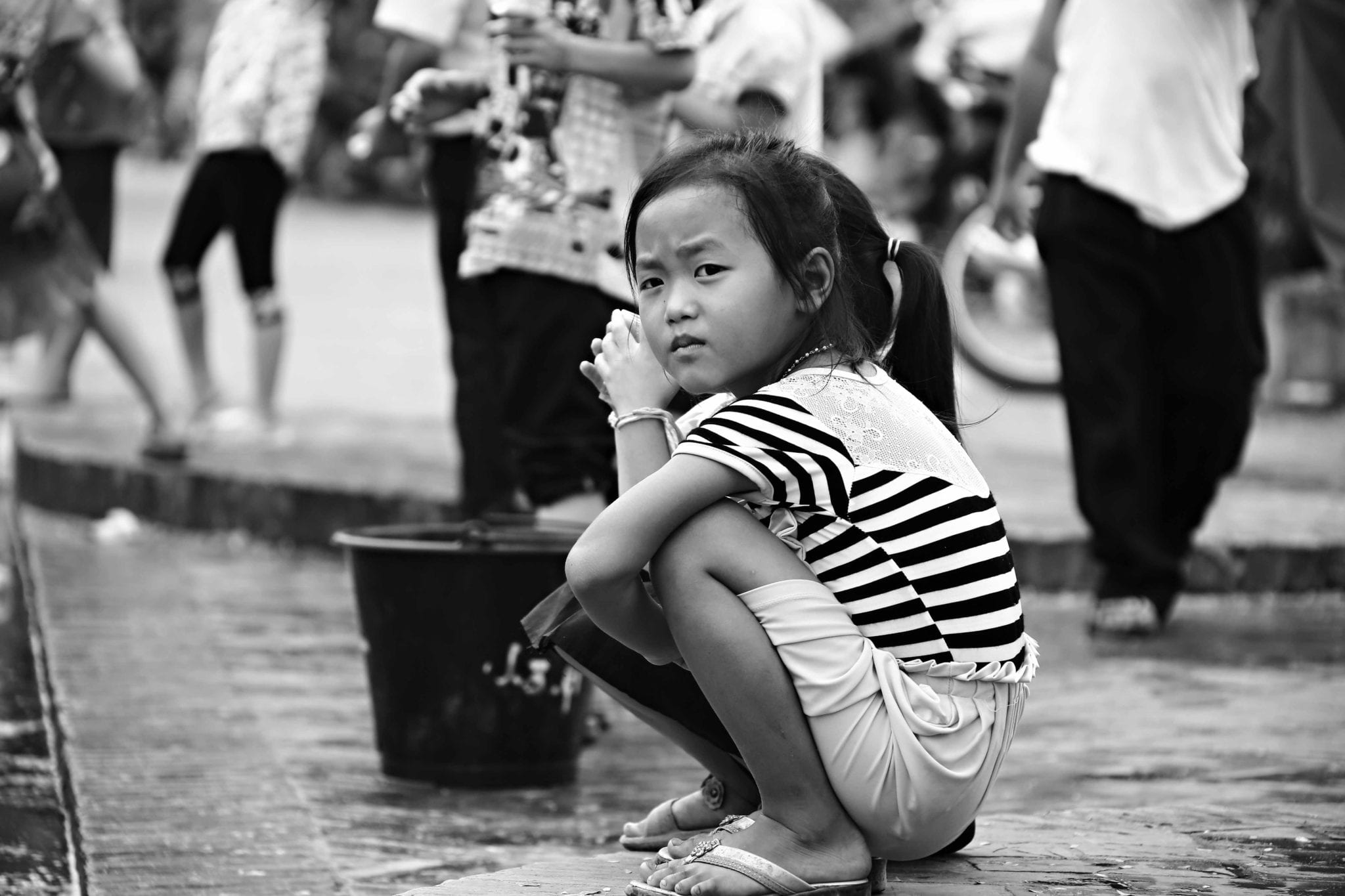
Our stay in Luang Prabang (“Loo-ong Prabong”) started with a bang – namely, the sound of a gallon of water slamming down onto the hood of the songtao. Pii Mai had started.
Pii Mai, Laos’s new year festival, sees thousands of gallons of water go airborne every day for at least four days every April, although the diehards get going early and keep the water flowing or several more days after the official end of the festival. I had read about the “water festival” prior to setting out on this trip and it was one of the things I was most looking forward to witnessing.
When we arrived in Vientiane, we were asked by numerous locals (but not Captain Happypants at the guesthouse, of course) what our Pii Mai location would be. Each time we said “Luang Prabang,” we received hearty nods, enthusiastic mimed gestures of buckets being tossed, and appreciative “Ahhhhhhs” – clearly, we’d made the right choice. As our songtao drove us through the city, I was suddenly not so sure. It was exciting, but it also rapidly became clear that we were going to spend our three days in LP utterly and completely soaking wet. We tried to put ourselves at peace with that, packed the camera gear in the bag and set off.
LP is a UNESCO World Heritage town, and with very good reason. The town is set up so that a good portion of it extends along the Nam Khong river to the south and east and the Mekong along the north, with a portion of the peninsula facing the confluence of the two rivers. Old colonial homes-turned-guesthouses and big shady trees line the one-way street system along the edge of the peninsula, giving the route a sheltered, cosy feel. We loved it instantly.
Travelling on foot in late-afternoon heat meant we were happy to walk near locals bearing water guns and water buckets for the occasional dousing and reciprocal “Pii Mai Laos!” exchanges. Having walked a good little route on day one, we decided to rent bikes on day two so that we could cover more ground without having to spend time retracing our footsteps. Morning is a quiet time on the Pii Mai water circuit, but by 10:30 there were groups lining the sidewalks, ready to hurl water at any passersby. We continued to be willing participants, squealing (especially Rich) as we raced through particularly busy stretches. My personal favourite was watching Rich run the gauntlet past two water stations, one on each side of the street, knowing they’d seen us coming and had gotten their buckets ready.
The great thing about the Lao approach to this festival is that they are quite adept at judging whether or not they should target you. If they’re unsure – which they were for the first day because the falang (foreigners) weren’t yet involving themselves very much – they splash little hands full of water in your direction and then it’s up to you to nod your acquiescence or just stop and let them douse you. Either way, there is eye contact, caution, and smiles – an excellent way to make sure that the fun remains good-natured.
We came across a street fight of sorts being wages between local school kids on opposite sides of the street. There was plenty of water, but also colouring (not sure what it was made from – it was similar to the water-based paint you get in those big plastic bottles in school, but less water-soluable) and corn starch. Yikes. I perched on the curb and watched them attack each other and observed as Rich got in on the action, too. Eventually, we were both soaking wet and laughing and I’d run out of space on my memory cards and had left my spares at home, so we hopped on our bikes and ran the gauntlet at high speed in the hopes that their aim would be poor when confronted with moving targets. It wasn’t. I didn’t know it was physically possible to be THAT wet! And so it went for three and a half full days.
By 10:30 the water stations were in full swing, and by 5 or 6 pm most had, mercifully, stopped. We bumped into Katrine several times and I nodded in agreement one day when she exclaimed, “There’s so much joy in the streets!” On the 14th, the day considered as the actual “Water Day,” everyone in town was in on the action. I made a brief detour into one of the city’s twelve active temple compounds and had a chat with several monks before returning to the street to face the watery mobs. My camera was safely stowed in the camera bag under the waterproof cover and wrapped in a plastic bag. It had spent a great deal of time like that over our three days in town, which was frustrating, but neither of us wanted to take any chances after I got splashed by one guy who threw water before looking and seeing my gear. We rode our bikes through multiple gauntlets and eventually stopped at a little restaurant with water stations on either side of the road. I took shelter under the awning and snapped away while Rich took his newly purchased water gun and got in on the action. It wasn’t long before the gun was abandoned in favour of the far more efficient bucket method. :)
Later on, some exploration on foot took us through a dripping crowd moving en masse through the puddles to some unknown tune while water flew through the air around them. It wasn’t until I was a few feet away that I realized what I was seeing: apparently, line dancing has universal appeal!
It was during the riot outside the restaurant that I noticed a subtle but distinct shift in the nature of the “fun”. The locals were still smiling away, but the smiles were starting to falter on the faces of the tourists; people were starting to get annoyed with each other, and the falang weren’t playing by the local rules – there was very little eye contact with their targets and often no consideration for them, either. I felt particularly bad for three girls who had the misfortune of having the leave town that day. Their bags were sealed in protective cases, so should’ve been – and probably were – okay, but the girls chose not to find a quieter side street and, instead, walked straight down the middle of the road, right through the chaos in front of me. Some inconsiderate moron decided it was appropriate to soak the front runner, who was suitably unimpressed. Both could’ve handled the situation much differently and walked away with some dignity, but poor decision-making meant that didn’t happen.
Throughout the festival, the Lao people continued to have a grand time identifying and acknowledging their targets, and then soaking them with increasing efficiency and exuberance as we got further into the celebrations, and it is this kind of positive exchange that will be what I remember. We also managed to crash yet another party while in LP and sampled yet more excellent local food. Mangosteens and rambutans (similar to lychees but with a way funkier outer shell), fried pork with sweet basil and garlic, stewed pork with ginger, crispy fried mushrooms… It was all excellent and happened simply because a fellow named Sai got chatting to Rich while we were exploring on our bikes one day and suggested we follow along to his teacher’s house, where there was a Pii Mai party. While we loved Cambodia and think Cambodians are fantastic examples of humanity, the welcome shown by Laos’s people has now humbled us twice.
The only thing I regret about our time in Luang Prabang is that I wasn’t able to take more photos. When the threat of a thorough soaking looms around every corner, it’s hard to be comfortable leaving your gear hanging off your shoulder. A visit outside of the Pii Mai festivities would allow more time to wander the temples late in the afternoon, when the sunlight through the trees casts a dappled glow across the ivory walls and the saffron robes seem to light on fire. For us, though, the city will forever be a symbol of smiles, dripping clothes and streets ringing with music and laughter.
Grateful for: towels.



